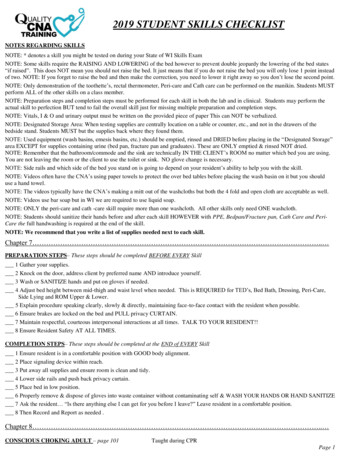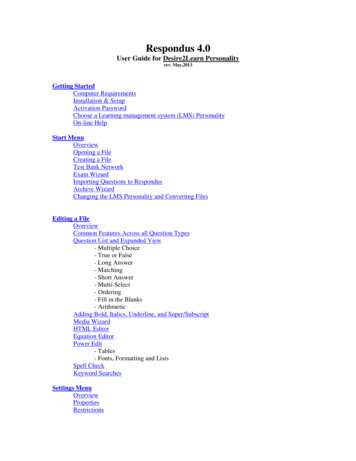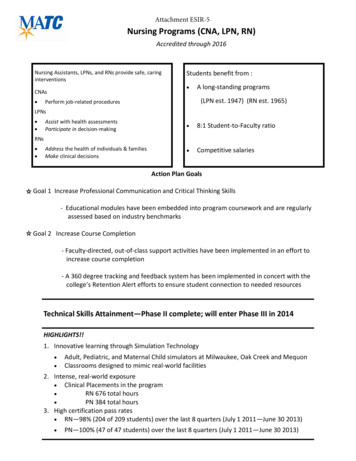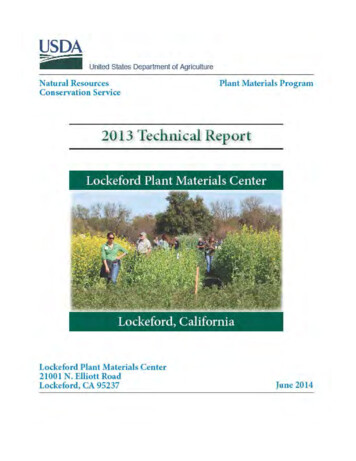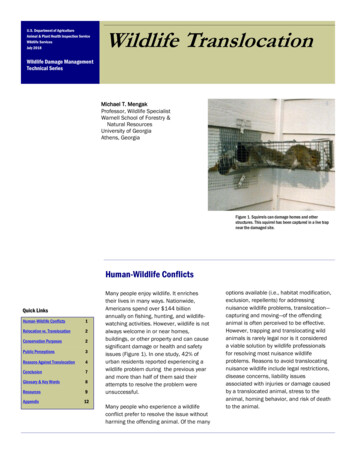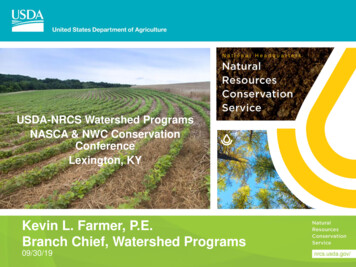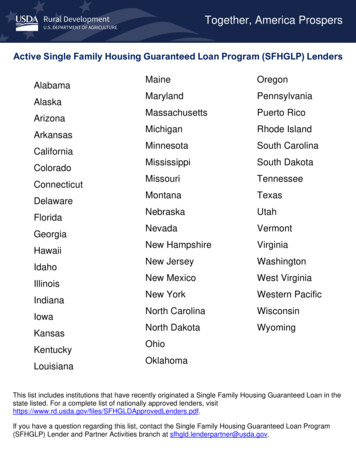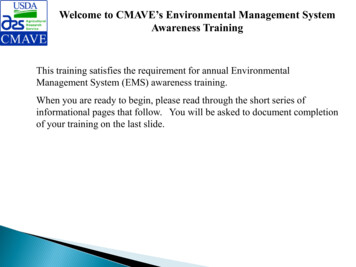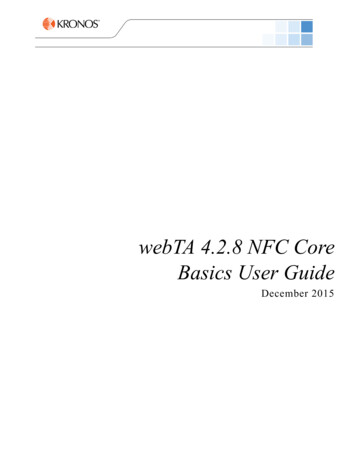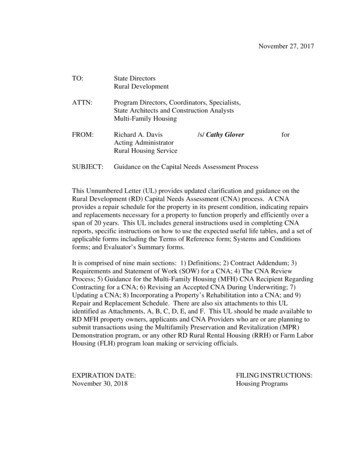
Transcription
November 27, 2017TO:State DirectorsRural DevelopmentATTN:Program Directors, Coordinators, Specialists,State Architects and Construction AnalystsMulti-Family HousingFROM:Richard A. DavisActing AdministratorRural Housing ServiceSUBJECT:Guidance on the Capital Needs Assessment Process/s/ Cathy GloverforThis Unnumbered Letter (UL) provides updated clarification and guidance on theRural Development (RD) Capital Needs Assessment (CNA) process. A CNAprovides a repair schedule for the property in its present condition, indicating repairsand replacements necessary for a property to function properly and efficiently over aspan of 20 years. This UL includes general instructions used in completing CNAreports, specific instructions on how to use the expected useful life tables, and a set ofapplicable forms including the Terms of Reference form; Systems and Conditionsforms; and Evaluator’s Summary forms.It is comprised of nine main sections: 1) Definitions; 2) Contract Addendum; 3)Requirements and Statement of Work (SOW) for a CNA; 4) The CNA ReviewProcess; 5) Guidance for the Multi-Family Housing (MFH) CNA Recipient RegardingContracting for a CNA; 6) Revising an Accepted CNA During Underwriting; 7)Updating a CNA; 8) Incorporating a Property’s Rehabilitation into a CNA; and 9)Repair and Replacement Schedule. There are also six attachments to this ULidentified as Attachments, A, B, C, D, E, and F. This UL should be made available toRD MFH property owners, applicants and CNA Providers who are or are planning tosubmit transactions using the Multifamily Preservation and Revitalization (MPR)Demonstration program, or any other RD Rural Rental Housing (RRH) or Farm LaborHousing (FLH) program loan making or servicing officials.EXPIRATION DATE:November 30, 2018FILING INSTRUCTIONS:Housing Programs
Page 21. DefinitionsThe following definitions are provided to clarify terms used in conjunction with the CNAprocess:CNA Recipient: This will be who enters into the contract with the CNA Provider. TheRecipient can be either the property owner or applicant/transferee.“As-Is” CNA: This type of CNA is prepared for an existing MFH property and reportsthe physical condition including all Section 504 Accessibility and Health and Safety items of theproperty based on that moment in time. This CNA can be useful for many program purposesother than the MPR Demonstration program such as: an ownership transfer, determiningwhether to offer pre-payment aversion incentive and evaluating or resizing the reserve account.The “as-is” report will include all major repairs and likely some minor repairs that are typicallyassociated with the major work: each major component, system, equipment item, etc. inside andoutside; building(s); property; access and amenities in their present condition. A schedule ofthose items showing the anticipated repair or replacement timeframe and the associated hardcosts for the ensuing 20-year term of the CNA serves as the basis or starting point in evaluatingthe underwriting that will be necessary to determine the feasibility and future viability of theproperty to continue serving the needs of eligible tenants.“Post Rehabilitation” CNA: This type of CNA builds on the findings of the accepted“as-is” CNA and is typically prepared for a project that will be funded for major rehabilitation.The Post Rehabilitation CNA is adjusted to reflect the work intended to be performed during therehabilitation. The assessment must be developed from the rehabilitation project plans and anyconstruction contract documents to reflect the full extent of the planned rehabilitation.Life Cycle Cost Analysis (LCCA): A LCCA is an expanded version of a CNA and isdefined at 7 C.F.R. Section 3560.11. The LCCA will determine the initial purchase cost, theoperation and maintenance cost, the “estimated useful life”, and the replacement cost of an itemselected for the project. The LCCA provides the borrower with the information on repair orreplacement costs and timeframes over a 20-year period. It also provides information that willassist with a more informed component selection and can provide the borrower with a morecomplete financial plan based on the predictive maintenance needs associated with thosecomponents. If the newly constructed project has already been completed without any previousLCCA requirements, either an “as-is” CNA or LCCA can be provided to establish programmandated reserve deposits. An Architect or Engineer is the best qualified person(s) to preparethis report.Consolidation: In some circumstances, RD may permit two or more properties to beconsolidated as defined in 7 CFR 3560, §3560.410 when it is in the best interests of theGovernment. The CNA Recipient must consult with the RD loan official before engaging theCNA Provider in any case where the CNA intends to encompass more than a single (one)existing RD property to determine if a consolidated CNA may be acceptable for RDunderwriting.
Page 32. Contract AddendumRD uses a Contract Addendum to supplement the basic CNA Agreement or “Contract”, betweenthe CNA Recipient and CNA Provider, with additional details and conditions. It can be found inAttachment A, Addendum to Capital Needs Assessment Contract and must accompany allcontracts executed between the CNA Recipient and CNA Provider for CNAs used in RDtransactions. If any conflicts arise between the “Contract” and “Contract Addendum”, the“Contract Addendum” will supersede.The Contract Addendum identifies the responsibilities and requirements for both the CNARecipient and the CNA Provider. To assure proper completion of the contract documents thefollowing key provisions must be completed:a. The Contract Addendum will include the contract base amount for the CNAProvider’s cost for services on page A-2, and provisions for additional services toestablish the total price for the CNA.b. Item I e, will require an itemized listing for any additional anticipated services andtheir unit costs including future updates and revisions that may be required beforethe CNA is accepted by RD. Note: Any cost for updating a CNA must beincluded, in the “additional services” subpart, of the original CNA Contract.c. The selection criteria boxes in II a, will identify the type of CNA being provided.d. In III a, the required language for the blank on “report format” is: “USDA RD CNATemplate, current RD version, in Microsoft Excel format”. This format will importdirectly into the RD underwriting template for loan underwriting purposes.3. Requirements and Statement of Work (SOW) for a CNAMinimum requirements for a CNA acceptable to RD can be found in Attachment B, CapitalNeeds Assessment Statement of Work. This is supplemented by Attachment C, Fannie MaePhysical Needs Assessment Guidance to the Property Evaluator. To resolve any inconsistencyin the two documents, Attachment B, the CNA SOW, will in all cases prevail over AttachmentC, Fannie Mae Physical Needs Assessment Guidance to the Property Evaluator. (For example,on page C-2 of Attachment C, Fannie Mae defines the “term” as “term of the mortgage and twoyears beyond”. For USDA, the “term” will be 20 years, as defined in the CNA SOW.)Attachment B includes the required qualifications for the CNA Provider, the required SOW for aCNA assignment, and general distribution and review instructions to the CNA Provider. TheCNA Providers must be able to report the current physical condition of the property and notbase their findings on the financial condition of either the property or the CNA Recipient.Attachment C is a three-part document RD has permission to use as reference to the CNAprocess throughout the RD MFH program efforts. The three key components of this Attachmentare: 1) guidance to the property evaluator; 2) expected useful life tables; and 3) a set of forms.
Page 4An acceptable CNA must appropriately address within the report and narrative all AccessibilityLaws and Requirements that apply to Section 515 and Sections 514/516 MFH properties. TheCNA Provider must assess how the property meets the requirements of accessibility to personswith disabilities in accordance the Uniform Federal Accessibility Standards (UFAS) and Section504 Accessibility Requirements. It is the responsibility of the Provider to inspect and verifywhether all accessibility features are compliant.4. The CNA Review ProcessA CNA used by RD will be reviewed by the designated RD CNA Reviewer with experience inconstruction, rehabilitation, and repair of MFH properties, especially as it relates to repair andreplacement.A CNA report must be obtained by the CNA Recipient from an independent third-party CNAProvider that has no identity of interest with the property owner, management agent,applicant/transferee or any other principle or affiliate defined in 7 CFR Part 3560, §3560.11.The CNA Recipient will contract with the CNA Provider and is therefore the client of theprovider. However, the CNA Recipient must consult with RD, before contracting with a CNAProvider to review Guidance Regarding Contracting for a CNA. The RD CNA Reviewer willevaluate a proposed agreement or engagement letter between the CNA Recipient and the CNAProvider using Attachment D, Capital Needs Assessment Guidance to the Reviewer, prior toreviewing any CNA report. Unacceptable CNA proposals, contracts or reports will be returnedto the CNA Recipient for appropriate corrections before they will be used for any underwritingdeterminations.The CNA Reviewer will also review the cost of the CNA contract. The proposed fee for theCNA must be approved as an eligible housing project expense under 7 CFR 3560.103 (c) for theagreement to be acceptable and paid using project funds. In most cases, the CNA servicecontract amount has not exceeded 3,500 based on the Agency’s most recent cost analysis.Borrowers and applicants are encouraged to obtain multiple bids in all cases. However, there isno Agency requirement to select the “low bidder” under this UL and the CNA Recipient mayselect a CNA Provider that will provide the best value, based on qualifications, as well as priceafter reviewing references and past work.If the CNA is funded by the property’s reserve account, a minimum of two bids is required if theCNA service contract amount is estimated to exceed 5,000 as specified in HB-2-3560, Chapter4, Paragraph 4.17 B. If the CNA contract under this UL is funded by another source, or will beunder 5,000, a single bid is acceptable.If the proposed agreement is acceptable, the reviewer will advise the appropriate RD servicingofficial, who will in turn inform the CNA Recipient. If the proposed agreement is unacceptable,the reviewer will notify the servicing official, who will notify the CNA Recipient and the CNAProvider in writing and identify actions necessary to make the proposed CNA agreementacceptable to RD. Upon receipt of a satisfactory agreement, the RD CNA Reviewer shouldadvise the appropriate RD servicing official or underwriting official to accept the proposal.
Page 5The CNA Reviewer will review the preliminary CNA report submits to RD by the CNAProvider using Attachment D, and write the preliminary CNA review report. During the CNAreview process, the CNA Reviewer and underwriter will consult with the servicing field officemost familiar with the property for their input and knowledge of the property. Any differencesof opinion that exist regarding the findings must be mutually addressed by RD staff. Ifcorrections are needed, the loan official will notify the CNA Recipient, in writing, of anyrevisions necessary to make the CNA report acceptable to RD. The CNA Reviewer will reviewthe final CNA report and deliver it to the loan official. The final report must be signed by boththe CNA Reviewer and the loan official (underwriter). Upon signature by both, this reportbecomes the “accepted” CNA indicating the actual condition of the property at the time of theCNA inspection – a “snapshot” in time – and will be marked “Current Property Condition” forindefinite retention in the borrower case file.A CNA Provider should be fully aware of the intended use for the CNA because it can impactthe calculations necessary to perform adequate accessibility assessments, and can impact theacceptability of the report by RD. Unacceptable reports will not be used for any RDunderwriting purposes even though they may otherwise be acceptable to the CNA Recipient oranother third-party lender or participant in the transaction being proposed.5. Guidance Regarding Contracting for a CNACNA Recipients are responsible for choosing the CNA Provider they wish to contract with, andfor delivering an acceptable CNA to Rural Development. RD in no way guarantees theperformance any Provider nor the acceptability of the Provider’s work.CNA Recipients are advised to request an information package from several CNA Providers andto evaluate the information before selecting a provider. At a minimum, the information packageshould include a list of qualifications, a list of references, a client list, and a sample CNA report.However, the CNA Recipient may request any additional information they feel necessary toevaluate potential candidates and select a suitable provider for this service. Consideration forthe type of CNA required should be part of the CNA Recipient’s selection criteria and insertedinto the contract language as well. The necessary skill set to perform the “as-is” versus the PostRehabilitation CNA or a LCCA needs to be considered carefully. Knowledge of theaccessibility laws and standards and the ability to read and understand plans and specificationsshould also be among the critical skill elements to consider.Attachment A, Contract Addendum must be submitted to RD with the contract, and signed bythe CNA Recipient and CNA Provider. The proposed agreement with the CNA Recipient andCNA Provider must meet RD’s qualification requirements for both the provider and the CNASOW, as specified in Attachment B, Capital Needs Assessment Statement of Work. RD mustreview the proposed agreement between the CNA Recipient and the CNA Provider, and concuronly if all of the RD requirements and conditions are met. (See the previous Section 3 of thisUL, The CNA Review Process.)Please note: It is in the CNA Recipient’s best interest to furnish the CNA Provider with themost current and up-to-date property information for a more comprehensive and thorough CNA
Page 6report. RD recommends that the CNA Recipient conduct a pre-inspection meeting with theOwner, Property Manager, maintenance persons familiar with the property, CNA Provider, andAgency Representatives at the site. This meeting will allow a forum to discuss specific detailsabout the property that may not be readily apparent to all parties involved during the reviewprocess, as well as making some physical observations on-site. Certain issues that may not beevident to the CNA Provider due to weather conditions at the time of review should also bediscussed and included in the report. Additionally, other issues that may need to be addressedinclude environmental hazards, structural defects, and complex accessibility issues. It isimperative that the Agency be fully aware of the current physical condition of the property at thetime the CNA is prepared. An Agency representative must make every effort to attend the CNAProviders on-site inspection of the property unless the Agency has performed a physicalinspection of the property within the previous 12 months.This pre-inspection meeting also allows the CNA Provider to discuss with the CNA Recipient totalnumber of units to be inspected, as well as identifying any specific units that will be inspected indetail. The minimum number of inspected units required by the Agency for an acceptable CNAis 50 percent. However, inspecting a larger number of units generally provides more accurateinformation to identify the specific line items to be addressed over the “term” being covered bythe CNA report. CNA Recipients are encouraged to negotiate with the CNA Provider to achieveinspection of all units whenever possible. The ultimate goal for the CNA Recipient and CNAProvider, as well as the Agency, is to produce the most accurate “baseline or snapshot” of currentphysical property conditions for use as a tool in projecting future reserve account needs.6. Revising an Accepted CNA During Underwriting (applies to RD actions)During transaction underwriting and analysis, presentation of the information contained in the“accepted” CNA may need to be revised by RD to address financing and other programmaticissues. The loan underwriter and the CNA Reviewer will work together to determine if revisionsare necessary to meet the financial and physical needs of the property, and established RDunderwriting or servicing standards and principals. These may involve shifting individual repairline items reported in the CNA, moving work from year to year, or other adjustments that willimprove cash flow. The revised underwriting CNA will be used to establish reserve fundingschedules as well as operating budget preparation and analysis, and will be maintained by RD assupporting documentation for the loan underwriting.The initial CNA, prepared by the CNA Provider, will be maintained as an independent thirdparty record of the current condition of the property at the beginning of the 20-year cycle.Original CNAs will be maintained in the case file, clearly marked as either “Current PropertyCondition” (“As-is”), “Post Rehabilitation Condition”, or “Revised Underwriting/ReplacementSchedule”, as applicable. Note: The CNA Provider is not the appropriate party to “revise” aCNA which has already been approved by the CNA Recipient and concurred with by theAgency. The CNA Provider’s independent opinion was the basis of the “As is” or “PostRehabilitation” CNA. The CNA developed for underwriting may only be revised by RD staffduring the underwriting process or as part of a post-closing servicing action.
Page 77. Updating a CNA (applies to “As-is” and “Post-Rehabilitation” that have not beenaccepted by RD)A completed CNA more than a year old at the time of the RD CNA review and approval must be“updated’ prior to RD approval. Likewise, if at the time of underwriting the CNA is more than ayear old (but less than two years old), it must be updated before the transaction can be approved.To update a CNA, the CNA Provider must review property changes (repairs, improvements, orfailures) that have occurred since the date of the original CNA site visit with the CNA Recipient,review costs and quantities, and submit an updated CNA for approval. However, if the site visitfor the CNA occurred more than two years prior to the loan underwriting, the CNA Providershould perform a new site visit to verify the current project condition.Once the CNA has been updated, the CNA Provider will include a statement noting “This is anupdated CNA of the earlier CNA dated ,” at the beginning of the CNA’sNarrative section. The CNA Provider should reprint the CNA with a new date for the updatedCNA, and provide a new electronic copy to the CNA Recipient and RD.If the CNA age exceeds 2years at the time of the RD CNA review and approval, the CNAProvider will need to repeat the site visit process to re-evaluate the condition of the property.The original report can remain the basis of the findings.8. Incorporating a Property’s Rehabilitation into a CNAA CNA provides a repair schedule for the property in its present condition, indicating repairs andreplacements necessary for a property to function properly and efficiently over a span of 20years. It is not an estimate of existing rehabilitation needs, or an estimate of rehabilitation costs.If any rehabilitation of a MFH development is planned as part of the proposed transaction, arehabilitation repair list (also called a “Scope of Work”) must be developed independently basedon the CNA repair schedule. This rehabilitation repair list may be developed by the CNARec
Nov 27, 2017 · CNA service contract amount is estimated to exceed 5,000 as specified in HB-2-3560, Chapter 4, Paragraph 4.17 B. If the CNA contract under this UL is funded by another source, or will be under 5,000, a single bid is acceptable. If the proposed agreement is acceptable, the reviewer will advise the appropriate RD servicingFile Size: 566KBPage Count: 61
